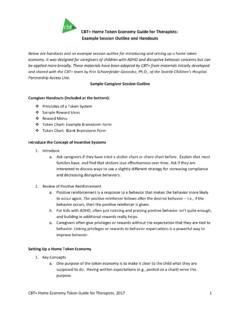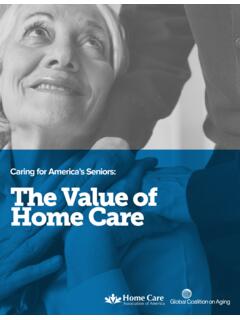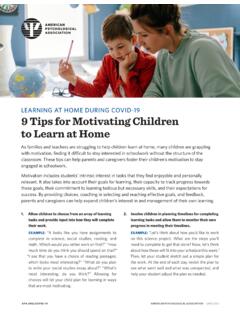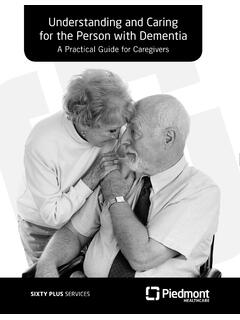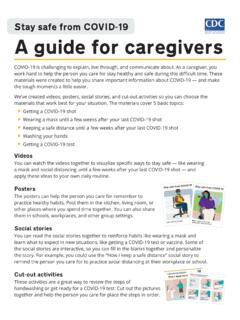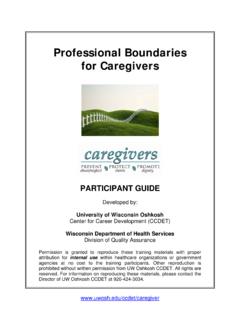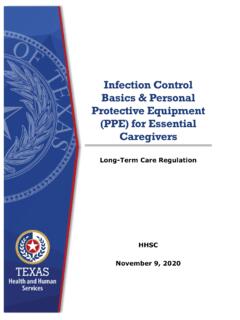Transcription of How Are We Doing? A Home Health Agency Self Assessment ...
1 How Are We Doing? A home Health Agency Self Assessment Survey on Patient Transitions and Family caregivers Well-planned and managed transitions are essential for high quality care and patient safety. Transitions occur when patients are admitted and discharged, when they move from one care setting to another (for example, from rehab or hospital to home with home care). Transitions also occur when home care ends. When family caregivers are informed about what is going to happen and prepared for their roles and responsibilities, transitions are smoother and more effective.
2 Yet home care agencies do not always focus on communication with family caregivers in a systematic and integrated way. For instance, does your Agency know how well it manages transitions? Does it involve caregivers in discharge planning? Does it assess a caregiver s ability and willingness to assist their family member after the end of home care? As part of its Next Step in Care campaign ( ), the United Hospital Fund, a nonprofit research and Health policy organization, designed a home Health Agency self- Assessment survey to help home care Agency staff evaluate how well they work with family caregivers in planning transitions.
3 A companion survey for family caregivers is also available. Self-assessments are important because they give you a realistic view of what is happening in the day-to-day practice of your Agency . They help you sort out problems that need considerable work from issues that appear to be working reasonably well and perhaps need only staff reminders to be on track. Unlike surveys in which you try to put your best foot forward, this is a survey that requires you to look at both feet honestly and constructively.
4 If the issues that arise through the survey process then become part of a multidisciplinary approach to fix the problems, your staff s day-to-day work should become more manageable and more satisfying. Utilizing the surveys at your Agency can provide you with the feedback necessary to improve quality of care, increase patient and family satisfaction, as well as provide staff the tools needed to better manage patient transitions. These self- Assessment surveys were piloted at a number of hospitals, rehab units in nursing homes, and home care agencies in New York City.
5 The results guided Fund staff and consultants in creating the guides and checklists available on the Next Step in Care website. The surveys are presented here in PDF format. If you want to add questions (for example, about a specific patient population), please contact us at 212-494-0760 or We will be pleased to work with you to make necessary adaptations. home Health Agency Self Assessment Survey Patient Transitions and Family caregivers How to Use the Self- Assessment Surveys These surveys are the initial steps in identifying areas of strengths and weaknesses around which an action plan can be developed to improve the quality of transitional care.
6 Here are some suggested steps in the process: 1. Designate someone to coordinate and monitor the process. 2. Determine whether you want to distribute the staff survey broadly throughout the Agency or target it to a specific unit or patient population. If you distribute the surveys broadly, you will need to assign different codes so that you know which unit is responding. 3. Make sure that there is broad representation among the staff taking the survey. Each person who completes the survey will have a different perspective, depending on whether he or she works in administration, finance, nursing, social work, or therapy.
7 4. All replies should be anonymous and surveys should be distributed in ways that allow staff to complete and return them without being identified. Stress that you are looking for what actually goes on, not what is supposed to happen. 5. You can print the survey for distribution and collate responses, or you can use an online survey service such as Survey Monkey, Polldaddy, or Zoomerang, which are easy to use and summarize the results for you. 6. Set reasonable deadlines for returning the survey.
8 7. Develop a plan for sampling family caregivers with the companion survey. 8. Compare family caregiver results with the staff findings to determine areas of agreement and disagreement. 9. Report findings back to all relevant staff members. Congratulate them on the strengths that you found. 10. Use the results to develop a plan to tackle the problems you identified. 11. If your plan involves integrating Next Step of Care materials into your practice, you may want to repeat the survey after a period of using the material to evaluate impact.
9 In addition to the surveys, you may want to consider other sources of information: Review of Agency s admission and discharge packet (What information is provided specifically for family caregivers ?) Focus groups with family caregivers , staff, community Agency personnel who serve your patients Review of patient satisfaction surveys to identify areas that are related to family caregivers home Health Agency Self Assessment Survey Patient Transitions and Family caregivers home Health Agency Performance Self- Assessment Survey Instructions for Completing the Survey The _____ is working to improve communication with caregivers in planning and managing transitions in care.
10 Transitions occur when patients are admitted and discharged, or move from one setting to another (for example, from hospital, rehabilitation facility, or nursing home to home and vice versa). Improvements in this area can impact quality of care and patient safety. To help us evaluate our work with family caregivers , we ask that you complete the attached anonymous survey by _____. The survey should take about 20 minutes to complete. Developed by the United Hospital Fund, a nonprofit research and Health policy organization, the survey asks questions about your experience with family caregivers of patients who are admitted to the homecare.


